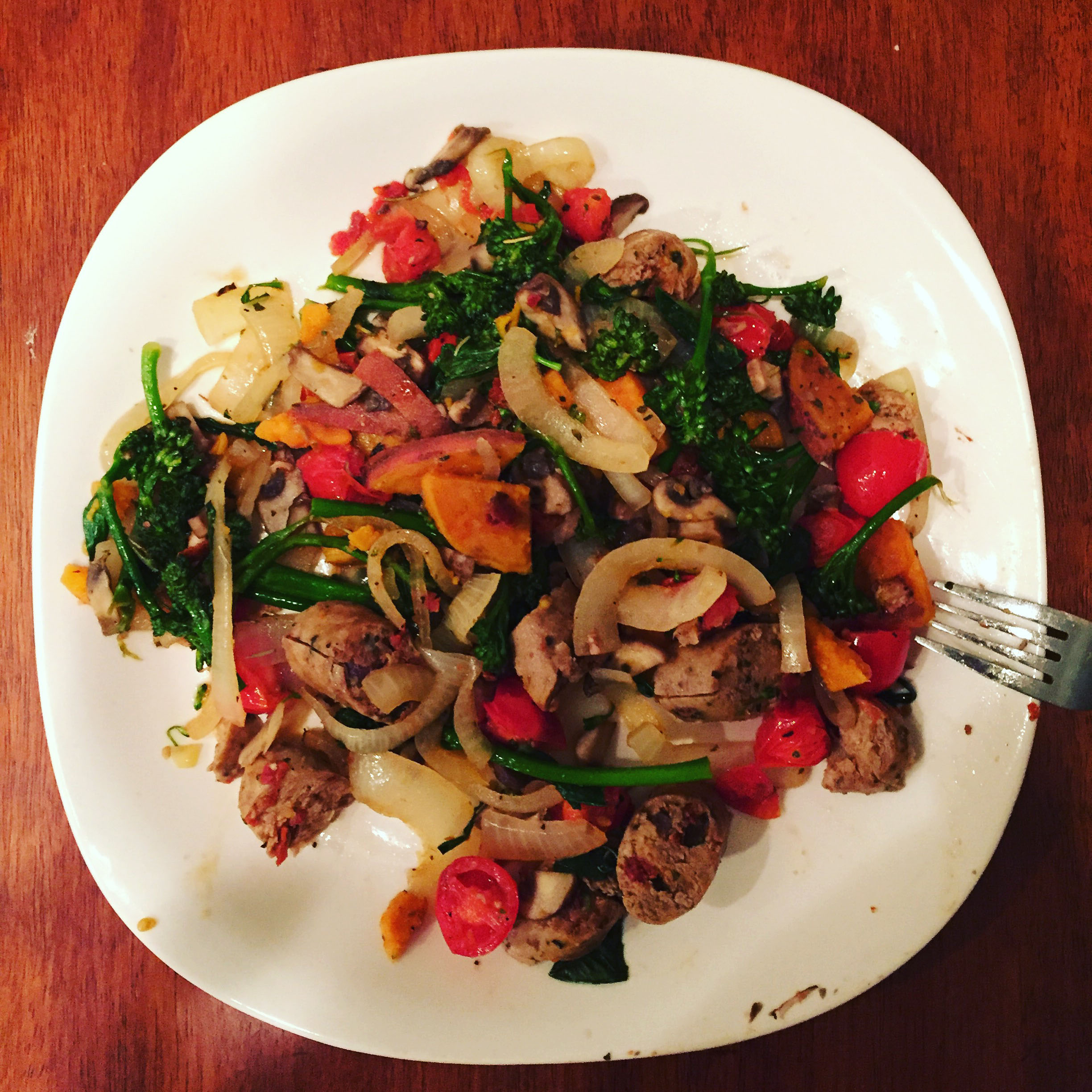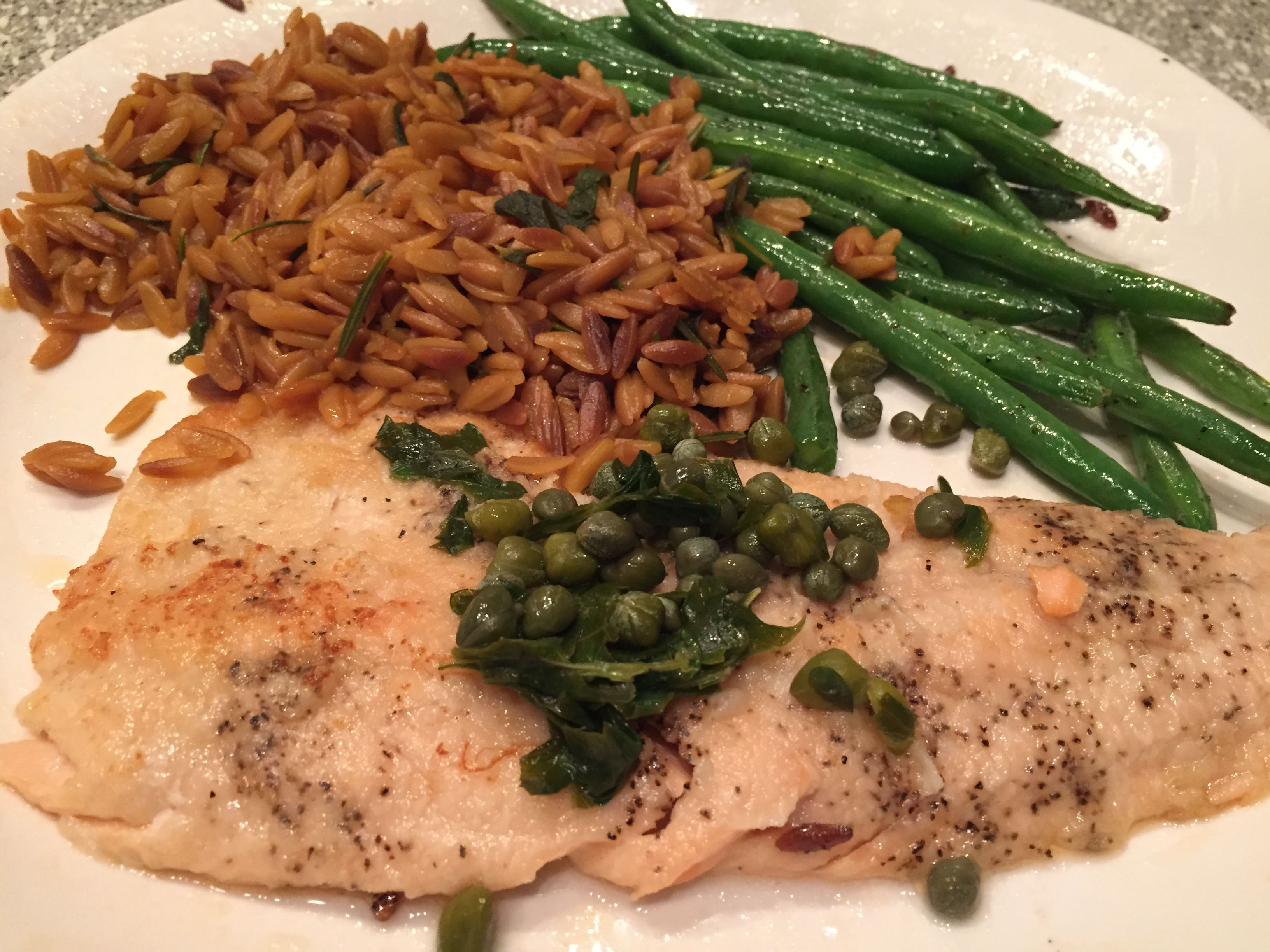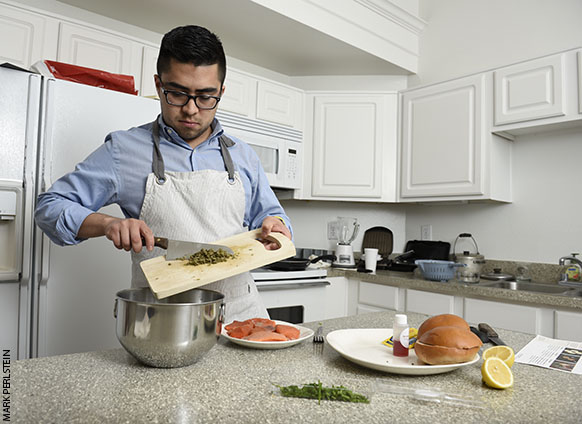The smoke alarms are blaring throughout my apartment building. They won’t stop. My roommate runs in from the living room to find me desperately waving a kitchen towel in the air to clear the smoke.
“What did you do?” he yells.
“I don’t know!” I say. “What do I do?”
Sympathetic for the panicked, deer-in-the-headlights look on my face, his tone quickly shifts from frustrated to almost motherly. Knowing he’s here to help, my shock dissipates and I run to open our patio door and the kitchen windows.
After what feels like half an hour (but is really only a couple of minutes), the alarms stop and the smoke clears. My roommate explains to me what I did wrong: the heat on the stove was too high, I burned the oil, and the pan I’m using is too small for the amount of vegetables I’ve prepared. He decides that talking me through this recipe and preventing me from burning down our apartment is worth more than his trip to the gym tonight.
***
I’m 24, and I’ve gotten most of this adult thing down. I’m never late for work. I get enough sleep. I recycle. I always pay my rent and car payments on time. I exercise regularly. But there’s one thing I can’t do: cook. Well, it’s not that I can’t—I just don’t. My definition of cooking involves buying a precooked rotisserie chicken, microwaveable spinach and 90-second instant rice. I don’t dislike cooking; I just never learned. Between living with my parents, college meal plans, and waiting tables when I was in school, cooking for myself was never a priority.
In March 2015 Americans spent more money at restaurants and bars than grocery stores for the first time ever.
I eat out, a lot, and I’m not alone in this. According to the U.S. Department of Commerce, in March 2015 Americans spent more money at restaurants and bars than grocery stores for the first time ever. The U.S. Healthful Foods Council reports Americans eat out 5.8 times per week. Grabbing spicy Buffalo wings at a bar during happy hour or picking up Chipotle on the way home from work is more convenient than buying groceries, prepping the ingredients, cooking the meal, packing away the leftovers and washing the dishes afterward.
This is why Nick Taranto and Josh Hix came up with Plated, a service that delivers fresh ingredients to your door. All you have to do is follow the recipe.
“After graduating from Harvard Business School with my co-founder, we both started working long hours in the corporate world and found ourselves eating greasy takeout far too often,” Taranto says. “We knew there had to be a better, healthier alternative to fit our hectic lifestyles, and when we didn’t find any readily available, we decided to work together to build our own solution. When we created Plated, we knew that we could change the eating habits of anyone who felt that they didn’t have the time or skill to cook a quality meal at home.”
Related: 6 Easy (and Tasty!) Ways to Eat Healthy
To learn how to cook, my editor tells me, I’ll be preparing four meals a week for one month using Plated. I can only be so excited. Sure, SUCCESS will pay for all of my meals, but I’m nervous because cooking is a skill I’ve never attempted to pick up. I worry about the time commitment and about messing up.
My anxiety grows even more the day the first big, brown, ice pack-cooled box with the red Plated logo arrives at the office. I open the box to find every ingredient I’ll need for four meals. After inspecting the produce, meat and spices, I pick up the recipe cards. I decide to start off with something I think will be fairly simple: chicken sausage stir-fry with broccolini and sweet potatoes.

Before I leave work, I study the recipe for half an hour at my desk. The recipe says to “heat a tablespoon of olive oil in a large pan over medium-high heat.” Which one is the tablespoon? What’s medium-high? My stove goes from 1-10. “When oil is simmering, add sausage in a single layer.” What’s simmering? How do I know when it’s simmering?
I head to yoga class which helps me relieve my anxiety about cooking, but only for an hour. As soon as the class says, “Namaste,” the nerves kick in again. Driving home, I recite the steps of the recipe in my head. OK, rinse the produce, then cut the produce. Cook the sausage. After that, cook the veggies and then mix everything. All right, Jesus, you’ve got this.
I pull into the parking lot of my apartment complex and heave the box of ingredients up to the third floor. I plop the box on my counter and store the food I’ll cook later this week, leaving out only what I need for tonight. After triple-checking to make sure I have everything I’ll need, I begin. Other than the agonizing searing of my eyes from peeling and cutting the onions, preparing and cutting the veggies is no problem for me. I carefully measure a tablespoon of olive oil, pour it in the pan and wait for it to simmer—except I don’t really know what simmering looks like. Five minutes pass, and I ask my roommate what I’m supposed to see.
“Bubbles. You’ll see bubbles,” he says, uninterested, as he watches another episode of Modern Family in the next room.
A few more minutes pass, but there are still no bubbles. I wonder if something’s wrong with my stove. Then I add a splash of oil and turn up the heat. Nothing. I text a co-worker to ask why it’s not simmering.
“How long has it been?” My co-worker texts back.
Before I can answer, the fire alarms go off.
After the smoke clears, with the guidance of my roommate, I successfully complete my first meal. A 25- to 35-minute recipe takes me an hour and 45 minutes to finish. It’s 10 p.m., and I’m too exhausted to eat. I sit down anyway and take my first bite. It’s actually pretty good. The sweet potatoes give the dish a surprising and unexpected flavor. What makes it even more satisfying is knowing I made it myself.
After an unsuccessful first day, I get help from an expert. Daphne Oz is co-host of ABC’s The Chew and author of Relish: An Adventure in Food, Style, and Everyday Fun.
Oz says she grew up in “a family of avid eaters,” so the kitchen is where she has all of her childhood memories. “It was where we did our bonding, our chatting. It was our playing field. It was our theater. It was our boxing ring. It was where we hashed everything out.”
I tell her about my cooking habits—or lack thereof—and my olive oil mishap.
“You need to get very comfortable with the idea that it doesn’t need to be perfect.”
“You need to get very comfortable with the idea that it doesn’t need to be perfect,” Oz says. “It needs to be delicious, but it doesn’t need to be this competitive thing. In the landscape today where everyone has so much access to food information, whether it’s on TV or the Internet, I think people just get anxiety about it. They kind of feel like they’re on a food competition show in their own kitchen.”
She reminds me that just like with any new skill, it’s all about practice.
Related: Want to Reach Your Potential? Then Be a Learner
“Don’t let it stress you out so much that it stops you from cooking because you’re worried that what comes out isn’t going to look like it does on the picture or it’s not going to be the way you ate it at a restaurant,” Oz says. “The kitchen is an extremely fast place to pick up a new skill.”
Day 2 goes much smoother. Trout piccata with rosemary orzo and green beans is the night’s recipe. The hardest part of this one is figuring out the difference between rosemary, parsley and oregano. My roommate breaks it down for me as if I’m 4 years old, “Rosemary is the spiky one, oregano is the baby one, and parsley is the big one.” But now that I know how to cook with olive oil, I’m feeling better in the kitchen. With my left hand, I’m sautéing green beans, and with my right, I’m stirring the rosemary orzo. This is actually fun.
The orzo comes out a little undercooked, and I probably could have cooked the green beans a little more, too. But the trout is perfect.
“I made this meal,” I tell my roommate after loading the dishwasher, as if maybe he’d forgotten. I also didn’t set the fire alarm off. And this is a lot healthier than the pizza I would have ordered.

In just two days, I realize how much work goes into preparing a meal and how much I’ve taken for granted every meal my mother ever made for me. So for Day 3, I prepare white bean poblano posole for the woman who made me so many home-cooked meals. Posole is a traditional Mexican soup; recipes vary, but they all include cooked hominy in broth. Coming from a Mexican family, it’s one of my favorite meals—one my mom is always sure to make for my birthdays. The recipe is fairly simple, and I feel confident enough to alter it, adding generous spoonfuls of ground jalapeño pepper to up the flavor.
Once the posole is ready, I pour the contents of the pot into a plastic bowl, clean up the kitchen, and cautiously chauffeur the soup to my parents’ house. My dad already ate dinner, but I tell my mom to take a seat at the table. The one who has always been served is now serving his mother: I plate the soup, garnishing it with some cheddar cheese and take two bowls to the table.
It’s delicious. Sheepishly, I look up from my bowl at Mom as she takes her first bite.
“It’s good,” she says, unmoved.
It’s good? That’s all? I’m devastated she’s not blown away by her firstborn’s wonderful concoction. But she’s had better. It doesn’t compare to her own. She tells me that she’s proud of me, but she’s doubtful I’ll continue cooking after my four-week experiment is over.
As the month goes on, the big brown boxes keep arriving, and I continue churning out palatable dishes such as lamb tacos, beef meatball ramen, salmon burgers and French bread pizza. I begin noticing I feel more fulfilled. Rather than spending my time playing FIFA, binge-watching House of Cards or scrolling through my Twitter feed, I’m spending my post-work hours becoming a more well-rounded person. And I like it.

I come to find cooking relaxing. After sitting eight hours in front of a computer screen, cooking gives me the opportunity to get my hands dirty—like mixing ground beef, diced onions, breadcrumbs, thyme and barbecue sauce to prepare meatloaf. It also gives me the chance to experiment—like adding extra beer to beer-braised chicken. I’m left feeling more satisfied with my day and even go to bed earlier because I’m more tired.
This kind of fulfillment is what I should expect from learning a new skill, says Denise Park, Ph.D., psychological scientist and director of research at the Center for Vital Longevity at the University of Texas at Dallas. In a 2013 study, Park and her colleagues randomly assigned 221 adults, ages 60 to 90, to learn a new skill 15 hours a week for three months.
“The participants were very committed to the study and enjoyed it immensely,” Park says. “Many participants learned that they could learn and took other courses later. Others did work for local newspapers and church newsletters based on their photography skills. Many stayed in touch with each other. Overall, participants appeared to find participation socially rewarding, as well as validating their ability and pleasure in learning new things.”
Individuals who participated in activities such as quilting and photography even showed enhanced brain activity, which is “an important element for maintaining a healthy brain into late adulthood,” Park says.
Though Park’s study didn’t include people under the age of 60, I clearly feel some of the same benefits. Not only am I making better use of my time—leaving me feeling more gratified—I’m eating healthier, too. Plated isn’t marketed as a diet plan. The company offers what they call a “holistic eating well solution,” with most meals between 600 and 800 calories.
By my last week cooking with Plated, my confidence in the kitchen has grown tremendously, but I’m also a little burned out. While I’ve enjoyed learning how to cook, making four meals a week has been exhausting. I’ve had to plan around my eating and some weeknights I was still cooking at 11 p.m. It turns out my mom was only partially right about how long I’d do this. While this kind of cooking won’t be a priority for me, I still plan on cooking a few times a week—following a short break.
After finishing my final meals—Buffalo chicken pizza and sticky Japanese chicken wings with carrot fries, which are huge hits at a Super Bowl party—I decide to prepare a meal for my co-workers. It’s an opportunity to show off my new cooking skills, and everyone loves a free lunch.
What I think will be easy, beef enchiladas with avocado sauce (see recipe), proves to be much harder—mainly because I’ve never cooked for so many people. My arms tire from mashing avocados and then I clumsily burn my fingertips on a pot of rice. I also underestimate how long it will take me to make everything and end up missing the first deadline of my SUCCESS career—23 minutes late to a lunch promised to be delivered at noon.
Quick to forgive my tardiness, my co-workers love the enchiladas—or at least that’s what they tell me. Whether they mean it or they’re just saying it to be polite doesn’t matter much. Four weeks ago, I couldn’t do something as simple as getting olive oil to simmer without setting off the smoke alarms, and today I’ve prepared a full meal for two dozen friends. And I’m not afraid to mess up anymore. It turns out that’s part of learning… and part of being an adult.
Related: 5 Tips to Overcome Your (Probably Irrational) Fears
This article originally appeared in the June 2016 issue of SUCCESS magazine.









